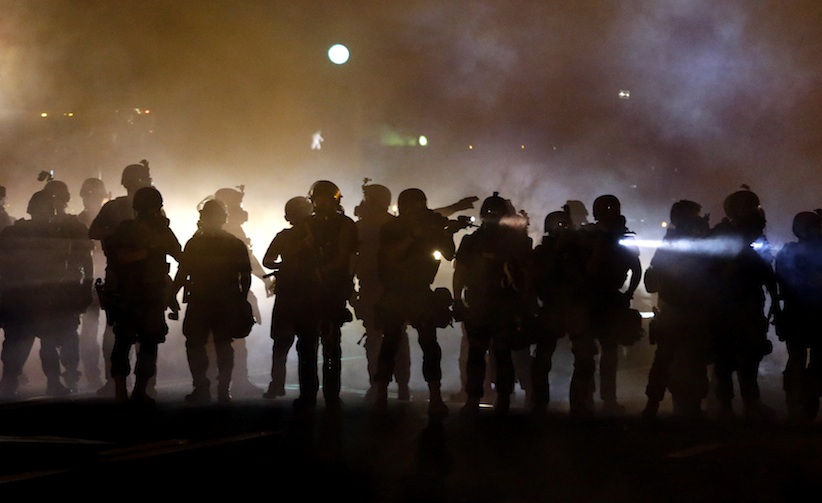Ferguson police chief names officer who fatally shot unarmed teen
Officer Darren Wilson was dispatched to the area after a reported robbery
Police walk through a cloud of smoke as they clash with protesters Wednesday, Aug. 13, 2014, in Ferguson, Mo. Protests in the St. Louis suburb rocked by racial unrest since a white police officer shot an unarmed black teenager to death turned violent Wednesday night, with people lobbing molotov cocktails at police who responded with smoke bombs and tear gas to disperse the crowd. (AP Photo/Jeff Roberson)
Share

FERGUSON, Mo. — The police chief in the St. Louis suburb where an officer fatally shot an unarmed teenager identified the officer on Friday as Darren Wilson, and said the officer was dispatched to the area after a reported robbery.
Ferguson Police Chief Thomas Jackson made the announcement after initially declining to the release the officer’s name, saying he had received numerous death threats. The officer has been on administrative leave since the shooting Saturday of 18-year-old Michael Brown, whose death has sparked several days of clashes with furious protesters in the city.
Jackson said Wilson, along with other officers, were called to the area after a 911 call reporting a “strong-arm” robbery just before noon Saturday at a convenience store. He did not say if Brown was a suspect in that robbery and refused to answer any questions, saying he would release more information later Friday.
But he said that a dispatcher gave a description of the robbery suspect, and Wilson, who had been assisting on another call, was sent to investigate. Wilson, a six-year veteran of the police department, encountered Brown just after 12:01 p.m., with a second officer arriving three minutes later.
Police have said Brown was shot after an officer encountered him and another man on the street. They say one of the men pushed the officer into his squad car, then physically assaulted him in the vehicle and struggled with the officer over the officer’s weapon. At least one shot was fired inside the car before the struggle spilled onto the street, where Brown was shot multiple times, according to police.
But a much different story has been told by Dorian Johnson, who says he was walking down the street with Brown when he was shot. He has said the officer ordered them out of the street, then grabbed his friend’s neck and tried to pull him into the car before brandishing his weapon and firing. He says Brown started to run and the officer pursued him, firing multiple times.
Tensions in the Ferguson boiled over after a candlelight vigil Sunday night, as looters smashed and burned businesses in the neighbourhood, where police have repeatedly fired tear gas and smoke bombs.
But on Thursday, county police in riot gear and armoured tanks gave way to state troopers walking side-by-side with thousands of peaceful protesters. The dramatic shift came after Gov. Jay Nixon assigned oversight of the protests to the state Highway Patrol, stripping that authority from the St. Louis County Police Department.
“All they did was look at us and shoot tear gas,” Pedro Smith, who has participated in the nightly protests, said Thursday. “This is totally different. Now we’re being treated with respect.”
The more tolerant response came as President Barack Obama spoke publicly for the first time about Saturday’s fatal shooting — and the subsequent violence that shocked the nation and threatened to tear apart Ferguson, a town of 21,000 that is nearly 70 per cent black and patrolled by a nearly all-white police force.
Obama said there was “no excuse” for violence either against the police or by officers against peaceful protesters.
Nixon’s promise to ease the deep racial tensions was swiftly put to the test as demonstrators gathered again Thursday evening. But the latest protests had a light, almost jubilant atmosphere among the racially mixed crowd, more akin to a parade or block party.
The streets were filled with music, free food and even laughter. When darkness fell — the point at which previous protests have grown tense — no uniformed officers were in sight outside the burned-out QuikTrip convenience store that had become a flashpoint for standoffs between police and protesters.
“You can feel it. You can see it,” protester Cleo Willis said of the change. “Now it’s up to us to ride that feeling.”
Nixon appointed Highway Patrol Capt. Ron Johnson, who is black, to lead the police effort. Johnson, who grew up near Ferguson and commands a region that includes St. Louis County, marched alongside protesters Thursday, joined by other high-ranking brass from the Highway Patrol as well as the county department. The marchers also had a police escort.
“We’re here to serve and protect,” Johnson said. “We’re not here to instil fear.”
Residents in Ferguson have complained about the police response that began soon after Brown’s shooting with the use of dogs for crowd control — a tactic that for some evoked civil-rights protests from a half-century ago. The county police had taken over the investigation of Brown’s shooting and security at the request of Ferguson.
Nixon vowed that “Ferguson will not be defined as a community that was torn apart by violence but will be known as a community that pulled together to overcome it.” The governor was joined at a news conference by the white mayor of St. Louis and the region’s four state representatives and the county executive, all of whom are black.
Attorney General Eric Holder has said federal investigators have interviewed witnesses to the shooting.